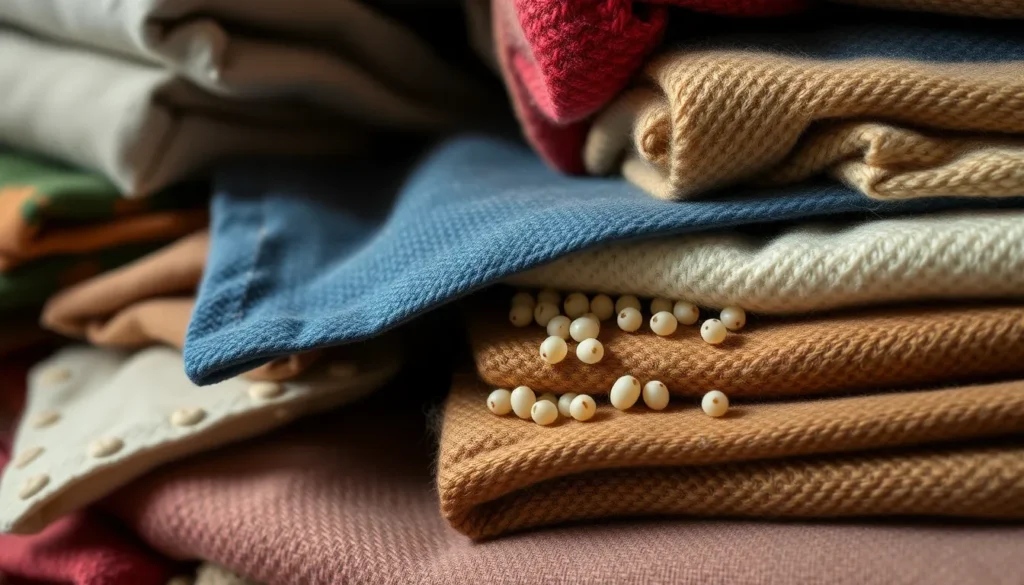Picture this: you’re getting ready for a big night out, and as you pull your favorite shirt from the closet, you spot tiny, suspicious-looking eggs nestled in the fabric. Surprise! Those little intruders are carpet beetle eggs, and they’re not just here for a fashion show. They’re on a mission to ruin your wardrobe and throw a party of destruction.
Table of Contents
ToggleOverview of Carpet Beetles
Carpet beetles belong to the family Dermestidae and include species like the common carpet beetle and the black carpet beetle. These pests thrive in households, typically invading clothing, carpets, and upholstery. Their larvae, which are often mistaken for small worms, cause the most significant damage by feeding on natural fibers such as wool, silk, and cotton.
Females lay eggs in hidden areas, often near food sources or nesting materials. The eggs hatch within 7 to 14 days, resulting in hungry larvae that start consuming fabrics. Adults emerge approximately two to five weeks later, continuing the cycle, as they seek out light sources and suitable habitats.
Signs of an infestation include damaged clothing, holes in carpets, and the presence of cast skins from larvae. Noticing these signs helps households identify and tackle potential problems early. Effective control methods include thorough cleaning, using vacuum cleaners, and washing infested clothing in hot water.
Prevention proves critical in keeping carpet beetles at bay. Regular inspections of clothing and storage areas reduce the likelihood of infestations. Sealing cracks and crevices also minimizes entry points for adult beetles seeking food and shelter.
Knowledge of carpet beetles and their lifecycle aids in effective management. Being proactive can save both time and money when safeguarding valuable garments and home textiles.
Identifying Carpet Beetle Eggs on Clothes

Spotting carpet beetle eggs on clothes requires keen observation. These eggs can lead to significant damage if left unaddressed.
Physical Characteristics of Carpet Beetle Eggs
Eggs typically measure about 1mm in length. They feature a smooth, oval shape and often appear white to cream-colored. Color changes may occur as they mature. Finding clusters of eggs in hidden spots such as seams or folds of clothing indicates potential infestations. Their tiny size makes them easy to overlook, heightening the threat to garments. Inspecting fabric near susceptible areas aids in early detection, preventing extensive damage.
Signs of Infestation
Identifying signs of a carpet beetle infestation involves looking for specific clues. Damage to clothes, such as small holes, signifies that larvae might be feeding. Discovered cast skins littering floor areas or furniture suggest growth and development of larvae. In addition, adults, which are small and range in color from black to mottled hues, may be spotted near infested items. Visible eggs or larvae in laundry piles or storage areas provides clear evidence of a problem. Regular inspections enhance the likelihood of finding these signs early, critical for effective management.
Impact of Infestation on Clothing
Carpet beetle infestations significantly damage clothing and textiles. Holes from feeding larvae appear on fabric, often ruining garments beyond repair. Commonly affected fibers include wool, silk, and cotton, with damage often becoming apparent after a short period.
Signs of infestation can include visible holes, irregular fabric thinning, and remnants such as cast skins. Larvae tend to target hidden areas, making detection challenging until substantial damage occurs. Adults contribute to the cycle by laying eggs, exacerbating the situation.
Long-term infestations lead to irreversible destruction of valuable clothing items. Expensive garments and cherished heirlooms often suffer the most. Layered fabric items, like coats or heavy sweaters, can trap larvae, increasing the risk of severe infestations.
Different carpet beetle species also exhibit varied feeding preferences. While some prefer animal-based fibers, others may target synthetics mixed with natural materials. Optimal conditions conducive to infestations include warm, dark spaces with ample food sources.
Effective management relies on awareness and early intervention. Regular cleaning routines and inspections help identify potential problems before severe damage occurs. Washing infested items in hot water and vacuuming can remove larvae and eggs, assisting in control efforts.
Heeding preventive measures reinforces the importance of protecting textiles. Use tightly sealed containers for storage, and consider utilizing moth-repelling products. An ongoing commitment to vigilance allows for maintaining a pest-free environment and safeguarding clothing collections.
Prevention Strategies
Preventing carpet beetle infestations involves effective cleaning and storage methods. Routine upkeep and strategic storage can significantly reduce risks.
Cleaning and Maintenance Tips
Regular cleaning plays a vital role in deterring carpet beetles. Vacuuming carpets, rugs, and upholstered furniture often removes debris and potential eggs. Focus on crevices and hidden areas where larvae may hide. Washing clothing in hot water eliminates eggs and larvae. Inspect closets and storage spaces monthly to catch any early signs. Use a lint roller to pick up stray hairs and fibers that attract pests. Keeping homes clutter-free also minimizes hiding spots for carpet beetles. This vigilant approach significantly reduces the chances of infestation.
Safe Storage Solutions
Utilizing safe storage solutions protects clothes from carpet beetles. Store items in airtight containers to prevent beetles from accessing them. Choose containers made from hard plastic rather than cardboard, which can be penetrated more easily. Ensure that all stored clothing is clean and dry to deter pest attraction. Consider using cedar blocks or lavender sachets, which repel beetles naturally. Label containers for easy access and organization, promoting awareness of contents. Following these storage practices helps maintain a pest-free environment and protects valuable items.
Treatment Options
Effective treatment options exist for addressing carpet beetle eggs on clothes. Both home remedies and professional extermination can provide relief from these pests.
Home Remedies
Natural remedies offer practical solutions for mild carpet beetle infestations. Vacuuming thoroughly removes visible eggs and larvae from clothing and common hiding spots. Washing infested items in hot water destroys eggs and larvae, ensuring a clean slate for clothes. Sprinkling diatomaceous earth in closets and around infested areas works as a natural insecticide, dehydrating and killing carpet beetles upon contact. Essential oils, like lavender and peppermint, serve as repellents when mixed with water and sprayed in infested spaces. Utilizing these methods, homeowners can manage minor infestations effectively.
Professional Extermination
For severe infestations, professional extermination often proves necessary. Pest control experts have access to specialized treatments that target carpet beetles more effectively than home remedies. Services typically include thorough inspections to identify infested areas and treatments tailored to specific needs. Professionals may apply insecticides that are safe for fabrics and powerful against carpet beetles. The preventative advice provided during these services can help reduce the risk of future infestations. Relying on expert intervention allows for a comprehensive approach to eradicating carpet beetles and protecting clothes.
Carpet beetle eggs on clothes can lead to significant damage if not addressed promptly. Recognizing the signs of an infestation and understanding the lifecycle of these pests is essential for effective management. Regular inspections and proper cleaning methods can help prevent these unwanted guests from ruining valuable garments.
Implementing safe storage solutions and using natural repellents can further protect clothing from potential infestations. For those facing severe issues, seeking professional help ensures a thorough treatment and long-term prevention strategies. Staying vigilant and proactive is key to safeguarding your wardrobe from carpet beetles.





